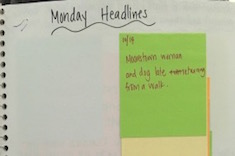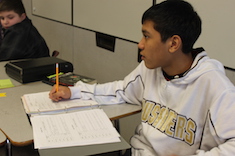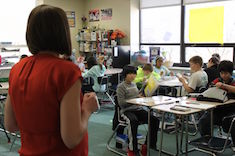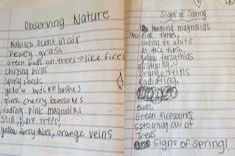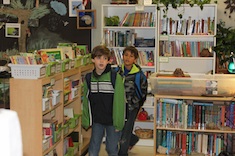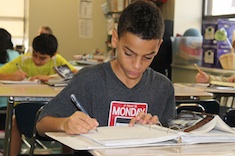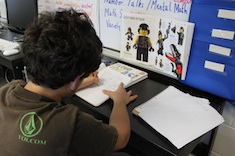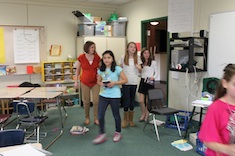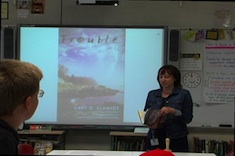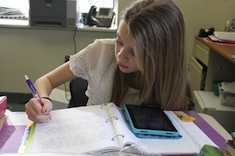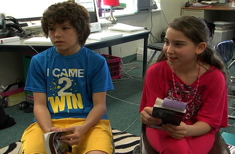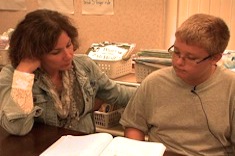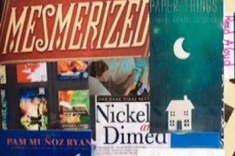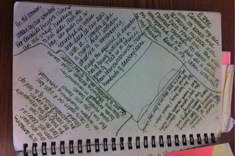6th
Latest Content
Monday Headlines
Tara Barnett and Kate Mills use Monday Headlines to energize students after the weekend, and get a peek into what’s going on at home.
Creating Curiosity with Story
Mark Levine finds that the secret to engaging students in what might be perceived as dry historical topics is to create curiosity with story.
Student (and Teacher) Risk-Taking
Carly Ullmer ponders what it means to take risks in her middle school classroom as she and her students experiment with different response options.
Not Just in April: Poetry All Year Long
Tara Smith finds that the 20 minutes she spends on poetry reading, analysis, and response in her sixth-grade classroom each week pay dividends all year long.
Loving Books or Reading?
Justin Stygles wonders why a love of books doesn't necessarily translate into a love of reading for his fifth and sixth graders.
Better Mondays Through Quick-Writes
Mark Levine uses quick-writes with his middle school students to set the expectation at the start of the week for work together that is independent, thoughtful, and conversational.
Pulling Weeds
Leigh Anne Eck works to overcome years of student reliance on a reading incentives and rewards program by fostering reflection and intrinsic motivation with her sixth graders.
Mentors for Process and Habits
Ruth Ayres shares some of her favorite mentors and mentor texts for developing good writing processes and habits.
Transition Time in Middle School
Gretchen Taylor considers how she handles hard transitions as an adult, and questions how she can make transitions more efficient and valuable for her middle school students.
Reflective Transitions
Christy Rush-Levine helps her eighth-grade students launch the work period with a reflective question that sets a tone for productivity, and then returns to it throughout the morning during transition times.
Book Talk: Trouble
Christy Rush-Levine previews the book Trouble by Gary D. Schmidt.
Last Chance Workshop
Christy Rush-Levine breaks her routine of responding to student writing, and instead calls on students to guide and support peers. She shares some surprising results.
Building Annotation Skills with Partners
Gretchen Taylor works from homework surveys to help her middle school students collaborate with partners to build annotation skills.
Deep Reading of Picture Books in Middle School
Christy Rush-Levine shows the power of using picture books with young adolescents to model close reading and deepen comprehension of sophisticated texts.
Strategies for Elaboration in Opinion Writing
Melanie Meehan works with fifth graders who are struggling to elaborate on themes in their opinion writing.
A Thesis Statement: Conferring with Connor
Ruth Ayres confers with sixth grader Connor about constructing a thesis statement.
Nonfiction Scrapbooks
Justin Stygles finds Nonfiction Scrapbooks are a fun way for his fifth-grade students to explore their reading interests and artistic talents with the classroom community.
Using Reading Notebook Covers for Reflection and Goal Setting
Clare Landrigan and Tammy Mulligan are using reading notebook covers in ingenious ways.
Conferring with Boys in Sixth Grade
Katie Doherty confers with boys in her sixth-grade reading workshop. This is the second installment in a two-part video series.
Conferring with Boys in Middle School
Katie Doherty circulates among sixth-grade boys in her reading workshop. These quick conferences and conferring tips are the first installment in a two-part series.
Strategies for Using Reader’s Notebooks
Melanie Swider enhances read alouds and the entire reading workshop with creative uses for reading notebooks.
Feed Forward
Carly Ullmer learns a powerful lesson about teaching her middle school students to respond to peer writing.
Donalyn Miller on Modeling Literate Lives (PODCAST)
Donalyn Miller, author of the acclaimed bestseller The Book Whisperer, chats with Franki Sibberson about the importance of teachers modeling their literate lives for students.
Closing Out the Year with “Where I’m From”
Jillian Heise shares a marvelous poetry writing activity for students who are transitioning from elementary to middle school, or middle to high school.
Student Learning Targets
Christy Rush-Levine finds she has to rethink learning targets for her middle school students if she wants students to pursue complex and lifelong reading goals.
Book Blurbs in the Middle School Classroom
Jillian Heise uses the quirky genre of book blurbs in her middle school classroom to model summaries and glean information about students’ comprehension, reading interests, and writing skills.
Researching Like Writers: From Read-Aloud to Notebooks
Katie Doherty finds read alouds are a valuable tool for developing middle school writers.
Giving Students a Notebook Tour
Melanie Meehan finds a notebooks tour is a terrific minilesson for helping students expand the ways they use notebooks.
Catching Up with Anna
Katie Doherty Czerwinski tackles the challenging issue of helping a student catch up in book clubs and reading workshop when they have missed a lot of class time.
Integrating Paraprofessionals into Reading Workshops
Justin Stygles decides he needs to completely rethink the role of classroom aides.
Browse Content By
Type
Category
- Assessment Tools
- Big Fresh Archives
- Booklists
- Choice Numeracy
- Classroom Design
- Common Core
- Community Building
- Conferring
- Content Literacy
- Digital Literacy
- English Language Learners
- Equity
- Family Relations
- Free Samples
- Guiding Groups
- Leadership
- Literacy Coaches
- Mentor Texts
- Minilessons
- New Teacher Mentors
- Podcasts
- Poetry
- Quote Collections
- Reading Strategies
- Self Care
- Struggling and Striving Learners
- Talking and Listening
- Teacher Study Groups
- Teaching Reading
- Teaching Writing
- Word Study and Vocabulary
Author
- Melissa Quimby
- Nawal Qarooni
- Gwen Blumberg
- Julie Cox
- The Lead Learners
- Hannah Tills
- Josie Stewart
- Ruth Metcalfe
- Mallory Messenger
- Becca Burk
- Jodie Bailey
- Vivian Chen
- Mary Brower
- Tiffany Abbott Fuller
- Stephanie Affinito
- Ruth Ayres
- Leigh Anne Eck
- Heather Fisher
- Shari Frost
- Julie Johnson
- Suzy Kaback
- Gigi McAllister
- Shirl McPhillips
- Melanie Meehan
- Cathy Mere
- Debbie Miller
- Tara Barnett and Kate Mills
- Tammy Mulligan
- Dana Murphy
- Bitsy Parks
- David Pittman
- Brenda Power
- Heather Rader
- Matt Renwick
- Mandy Robek
- Christy Rush-Levine
- Gretchen Schroeder
- Jen Schwanke
- Brian Sepe
- Katherine Sokolowski
- Stella Villalba
- Jennifer Vincent
Grade Level
Choice Literacy Membership
Articles
Get full access to all Choice Literacy article content
Videos
Get full access to all Choice Literacy video content
Courses
Access Choice Literacy course curriculum and training

